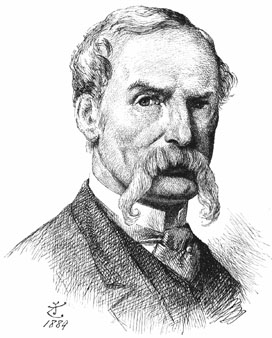| Sir John Tenniel  Born: 28-Feb-1820 Born: 28-Feb-1820
Birthplace: London, England
Died: 25-Feb-1914
Location of death: London, England
Cause of death: unspecified
Gender: Male
Race or Ethnicity: White
Occupation: Artist Nationality: England
Executive summary: Illustrator for Punch English humorous and satirical artist -- specially identified with Punch -- born in London in 1820. He educated himself for his career, and although he became a probationer, and then a student, of the Royal Academy, he soon left the schools, where at that time there was little teaching. In 1836 he sent his first picture to the exhibition of the Society of British Artists, and in 1845 contributed a 16-ft. cartoon, "An Allegory of Justice", to the competition, held in that year, of designs for the mural decoration of the new Palace of Westminster. For this he received a £200 premium and a commission to paint a fresco in the Upper Waiting Hall (or "Hall of Poets") in the House of Lords. In spite of his tendency towards high art, he was already known and appreciated as a humorist, and his early companionship with Charles Keene fostered and developed his talent for scholarly caricature. At Christmas time 1850 he was invited by Mark Lemon to fill the position of joint cartoonist (with John Leech) on Punch, from which Richard Doyle, offended by the attitude adopted by the paper towards the Papal see at the time of the so-called "aggression", had suddenly resigned. On the strength of his remarkable illustrations to Aesop's Fables, in which artistic power, humor of observation, and knowledge of animal life were equally apparent, Tenniel was selected, on Douglas Jerrold's initiative, to fill the breach, and he contributed his first drawing in the initial letter appearing on p. 224, vol. XIX. His first cartoon was "Lord Jack the Giant Killer": it showed Lord John Russell, whose letter on the "aggression" had recently been published, valiantly assailing with the sword of truth and liberty Cardinal Wiseman armed with a crozier. In 1852 we find Tenniel's first superb lion, and his first obituary cartoon. Gradually he took over altogether the weekly drawing of the political "big cut", which John Leech was happy to resign into his hands in order to restrict himself to his pictures of life and character. Leech's work consisted for the most part of farce; Tenniel's was high comedy, and not infrequently tragedy; and the freedom of the humorist heightened the severer beauties of the satirist. When Leech died his friend continued his work alone, and except in 1864, 1868, and 1875-78, during short spells of illness or holiday, he did not miss a single week. About 2300 cartoons, innumerable minor drawings, double-page cartoons for Punch's Almanac and other special numbers, and 250 designs for Punch's Pocket-books, comprise the sum of Sir John Tenniel's work for the periodical in the service of which he spent the greater portion of his life. When Tenniel retired from the service of Punch in January 1901 he received the honor of a farewell banquet (12th June), at which Arthur Balfour, then leader of the House of Commons, presided, and was supported by distinguished representatives of all that was best in English life. On that occasion Balfour's description of Tenniel as a great artist and a great gentleman was applauded by the press of the whole country.
The main quality of Sir John Tenniel's work is accuracy of drawing, precision of touch, grace and dignity of conception, and -- so far as such things can be compatible -- geniality of satire. Tenniel raised the political cartoon into a classic composition, from which a sense of nobility is rarely absent. The beauty and statuesqueness of his ideal figures recall the influence, perhaps, of Cornelius and Overbeck -- that German manner which was characteristic of many of our finer draughtsmen upon wood at the middle of the 19th century. But Tenniel's work is always original, unforced and fresh; and it never suggests, what is the fact, that the artist's work is drawn exclusively from memory, and never from the model. It may be mentioned that Tenniel's wonderful observation has been conducted, and his knowledge accumulated, literally through a single eye, the other having been lost during a fencing bout in his youth. It was in recognition not only of his ability as an artist in black and white, but of his service in infusing good humor and good taste into one phase of political life, that a knighthood was conferred upon him on William Ewart Gladstone's recommendation in 1893. Without pronounced political opinions of his own, Sir John Tenniel adopted in his work those of his paper, of which the Whig proclivities were to some degree softened by his pencil. The political history not of England only, but to some extent of the world, of half a century appears in Sir John Tenniel's weekly cartoons, which are dignified by a number of types invented by the artist, the classic beauty of which may he looked for in vain in kindred work by any previous cartoonist. (Take, for example, Sir John's famous picture of "Dropping the Pilot", which appeared in Punch on 20th March 1890, XCVIII, 150-51.) Public exhibitions of Sir John Tenniel's work were held in 1895 and in 1900. Sir John Tenniel is also the author of one of the mosaics, "Leonardo da Vinci", in the South Court in the Victoria and Albert Museum; while his highly stippled watercolor drawings appeared from time to time in the exhibitions of the Royal Institute of Painters in Water Colors, of which society he was elected a member in 1874. As an illustrator on the wood-block he stands very high; his "Lalla Rookh" is perhaps the finest of all his work in point of conception, refinement, power and technical excellence.
University: Royal Academy
Punch
Requires Flash 7+ and Javascript.
Do you know something we don't?
Submit a correction or make a comment about this profile
Copyright ©2019 Soylent Communications
|